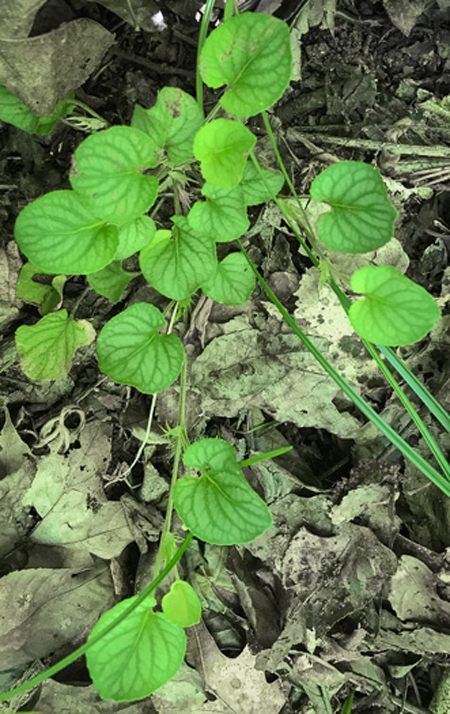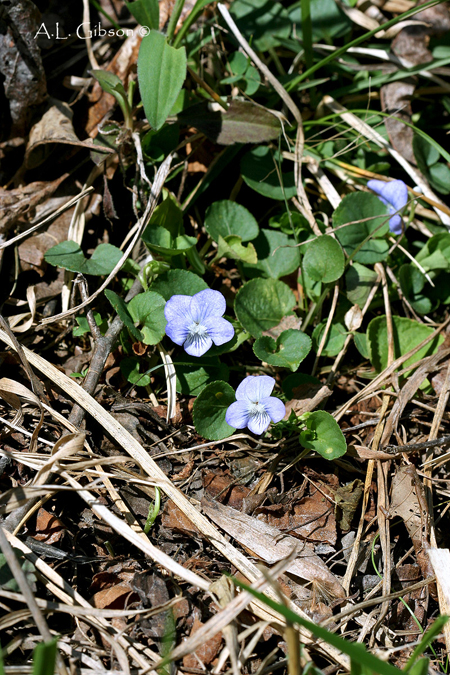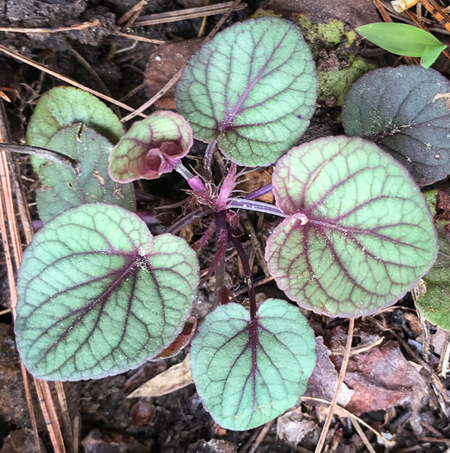Viola walteri House
Common names:
Prostrate Blue Violet, Walter's Violet
Synonyms:
Viola walteri House, Torreya 6: 172. 1906 [replacement name for Viola canina Walter]; Viola canina Walter non L., Fl. carol.: 219. 1788. TYPE: USA, South Carolina, Berkeley Co., near Goose Creek, woods, 30 Mar 1933, F. W. Hunnewell 12638 (NEOTYPE (designated by Daniel Ward, J. BRIT 2: 485. 2008): GH00277012, internet image!).
Viola multicaulis (Torr. & A.Gray) Britton, Mem. Torrey Bot. Club 5: 227. 1894 [illegimate homonym of V. multicaulis; Viola canina Walter var. multicaulis (Torr. & A.Gray) A.Gray, Bot. Gaz. 11(11): 292. 1886; Viola muhlenbergii Torr. var. multicaulis Torr. & A.Gray, Fl. N. Amer. 1(1): 140. 1838
Description:
Caulescent mat-forming perennials from somewhat slender rhizome, flowering stems short and ascending, later prostrate, persistent and node-rooting, commonly ≥ 2, ≤ 7 cm tall; stems, foliage and peduncles gray-green and upper surface of leaf blades weakly to prominently bicolorous with darker green veins, or stems, peduncles and lower surface of leaf blades strongly tinged or finely spotted with purple and upper surface of leaf blades with purple veins, foliage and peduncles densely puberulent; leaves cauline and basal, cauline distributed along stem; stipules free, deeply laciniate with marginal processes > 1/2 as long as the stipule; leaves ascending to spreading, leaf blades undivided, largest ≤ 32 × 29 mm, broadly ovate to reniform (rarely ovate), base deeply cordate, margins crenulate to serrate, ciliolate, apex broadly rounded to obtuse; chasmogamous flower ≤ 16 mm; calyx glabrous, eciliate; lowest sepals lanceolate, acute; auricles short and entire, not elongating in fruit; corolla medium to dark blue, with white throat extending onto base of lateral and spurred petal; spur moderately elongate, slender, 3&ndash5 mm, white to medium or dark blue; lateral petals densely bearded with filiform to narrowly linear hairs, spurred petal glabrous; cleistogamous flowers produced after chasmogamous; capsule 5.0–7.0 mm, green drying tan, unspotted or with fine red spots or faint blotches, glabrous; seeds 1.7–2.4 × 1.0–1.4 mm, medium to dark brown, unspotted; 2n=20.
Similar species:
Viola appalachiensis, Viola hirsutula, Viola labradorica, Viola odorata
Ecology:
Nutrient-rich woodlands and forests, dolomite bluffs and ledges, especially on mafic or calcareous rocks, growing beneath Juniperus, in the northern half of its range, and in sandy or rocky and often somewhat acidic soils in dry or dry-mesic forests under Pinus and/or Quercus in the Southeast.
Distribution:
Widely distributed in the s. Appalachian Mountains, s. Piedmont and s. Atlantic and Gulf Coastal Plains, sporadic and rare to the north in the higher elevations of the c. Appalachians and Western Allegheny Plateau; w. VA, e. WV and c. OH south to peninsular FL, AR, and e. TX
Rarity:
State listed in KY, NC, OH; and VA [as V. walteri var. walteri].
Phenology:
Chasmogamous flower (late January-)March–May, chasmogamous fruit May–June, cleistogamous fruit July–August.
Affinities:
This species belongs to the Rostrate Violet lineage, sect. Viola, subsect. Rostratae (Kupffer.) W.Becker.
Hybrids:
Hybridizes with V. labradorica (Ballard 1992, 1993) and V. striata (Ballard 1992, 1993). I have observed the hybrids and have found the features of chasmogamous flowers and foliage to be more or less precisely intermediate. Hybrids fail to reproduce by chasmogamous flowers, and cleistogamous capsules fail to produce viable seeds.
Comments:
Walter misapplied the name V. caninaL., belonging to a European violet, to a totally different North American species. Nearly 120 years later, House provided a replacement name. Ward (2007) presented evidence that the collections in the Walter Herbarium are not necessarily those on which Walter's names were based. He subsequently neotypified Walter's basionym V. canina to fix the application of that name (as well as House's V. walteri).
Brainerd (1921b), Brainerd Baird (1942), Fernald (1950), and Alexander (1963) recognized V. walteri narrowly, although Brainerd Baird mentioned a Maryland locality which is undoubtedly a misidentification of V. appalachiensis, a species which had not yet been recognized. Davis and Davis (1949) and Platt (1950) drew attention to anomalous populations of a mat-forming node-rooting rostrate violet in West Virginia, Pennsylvania and Maryland that differed in several macromorphological features from V. walteri, and Henry (1953a, 1953b) promptly studied and named them V. appalachiensis. Russell (1965) later studied populations of V. appalachiensis and pronounced them either depauperate V. conspersa [= V. labradorica as treated here] or V. walteri bordering on the former. Ballard (1992) and Ballard and Wujek (1994) conducted a full-scale systematic study on the complex and related rostrate violets, and documented many consistent macromorphological differences and a different style micromorphology, as well as modally different habitat, to support recognition of both as distinct evolutionary species. Strausbaugh and Core (1978) and Ballard (2000) continued to recognize both as distinct species; Gleason and Cronquist (1991) merged the two without recognition of infraspecific taxa, while McKinney and Russell (2002), Grund and Isaac (2007), Weakley et al. (2012), and Little and McKinney (2015) demoted V. appalachiensis to a variety under V. walteri. Given the several consistent macromorphological and morphological distinctions and clearly different ecological niches as evidence, the two taxa are accepted as distinct species here. While the two share a mat-forming habit by persistent prostrate node-rooting stems, the present species is easily distinguished by its puberulent foliage and peduncles, conspicuously bicolorous upper leaf blades, and deeply laciniate stipules. It occupies consistently drier habitats than V. appalachiensis and other rostrate violets in its range.
Literature Cited:
Alexander, E. J. 1963. Violaceae. In Gleason, H. A., The new Britton and Brown illustrated flora of the northeastern United States and adjacent Canada. Hafner Publishing Co., Inc., New York, NY. 552-567.
Ballard Jr., H. E. 1992. Systematics of Viola section Viola in North America north of Mexico. M.S. thesis. Central Michigan University, Mount Pleasant, MI.
Ballard Jr., H. E. 1993. Three new rostrate violet hybrids from Appalachia. Castanea 58: 1-9.
Ballard Jr., H. E. 2000. Violaceae. In Rhoads, A. (ed.). Flora of Pennsylvania. University of Pennsylvania Press, Philadelphia, PA. 700-710.
Ballard Jr., H. E., and D. E. Wujek. 1994. Evidence for the recognition of Viola appalachiensis. Systematic Botany 19: 523-538.
Brainerd, E. 1921b. Violets of North America. Vermont Agricultural Experiment Station Bulletin 224: 1-172.
Brainerd Baird, V. 1942. Wild violets of North America. University of California Press, Berkeley, CA.
Davis, H. A. and T. Davis. 1949. The violets of West Virginia. Castanea 15: 53-87.
Fernald, M. L. 1950. Violaceae. In Gray's Manual of Botany, 8th ed. American Book Company, New York, NY. 1022-1042.
Gleason, H. A. and A. Cronquist. 1991. Violaceae. In Manual of vascular plants of northeastern United States and adjacent Canada, 2nd ed. New York Botanical Garden, Bronx, NY. 157-163.
Grund, S. P. and B. L. Isaac. 2007. Taxonomy and lectotypification of Appalachian Blue Violet. Castanea 72(1): 58-61.
Henry, L. K. 1953a. The Violaceae of Pennsylvania. Castanea 18(2): 37-59.
Henry, L. K. 1953b. Viola appalachiensis, nom. nova, a substitution for Viola allegheniensis Henry. Castanea 18(4): 131.
Little, R. J., and L. E. McKinney. 2015. Violaceae. In Flora of North America: Cucurbitaceae to Droseraceae, 106. Oxford University Press, New York, NY.
McKinney, L. E., and N. H. Russell. 2002. Violaceae of the southeastern United States. Castanea 67: 369-379.
Platt, R. B. 1950. Two mid-Appalachian violets. Castanea 15: 126-129.
Russell, N. H. 1965. Violets (Viola) of the central and eastern United States: An introductory survey. Sida 2: 1-113.
Strausbaugh, P. D. and E. L. Core. 1978. Violaceae. In Flora of West Virginia, 2nd ed. Seneca Books, Inc., Morgantown, WV. 644-658.
Ward, D. B. 2007. The Thomas Walter Herbarium is not the herbarium of Thomas Walter. Taxon 56(3): 917-926.
Weakley, A. S., J. C. Ludwig, and J. F. Townsend. 2012. Violaceae. In Flora of Virginia. BRIT Press, Fort Worth, TX. 963-975.

Mat-forming prostrate stems ("stolons") (plant at GA, Crawford Co., May) by J. K. Marlow, "Native and Naturalized Plants of the Carolinas and Georgia" website

Chasmogamous flowering habit by Andrew Gibson, "Buckeye Botanist" website

Chasmogamous flowering habit (plant at GA, Rabun Co., April) by J. K. Marlow, "Native and Naturalized Plants of the Carolinas and Georgia" website

Leaves during chasmogamous flower (plant at GA, Rabun Co., April) by J. K. Marlow, "Native and Naturalized Plants of the Carolinas and Georgia" website

Chasmogamous flower front view by Andrew Gibson, "Buckeye Botanist" website

Map by the USDA Plants Database